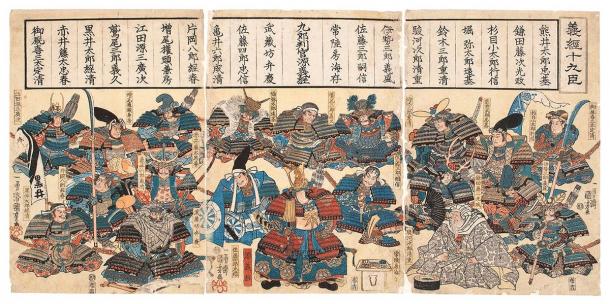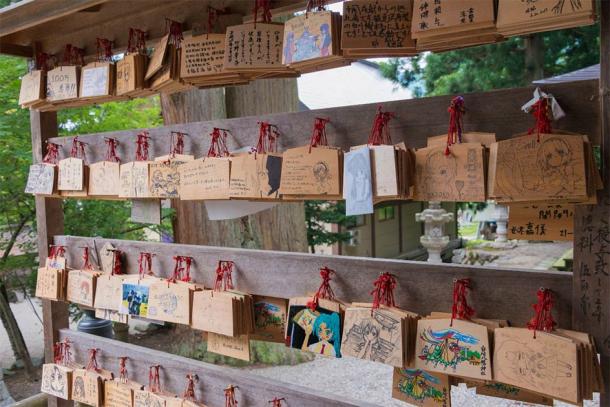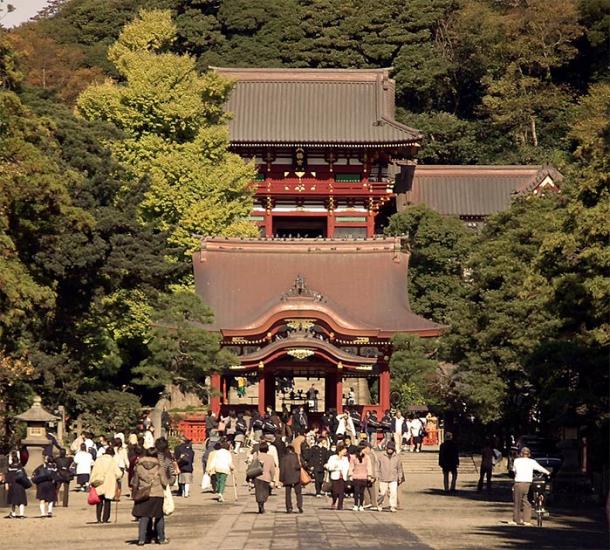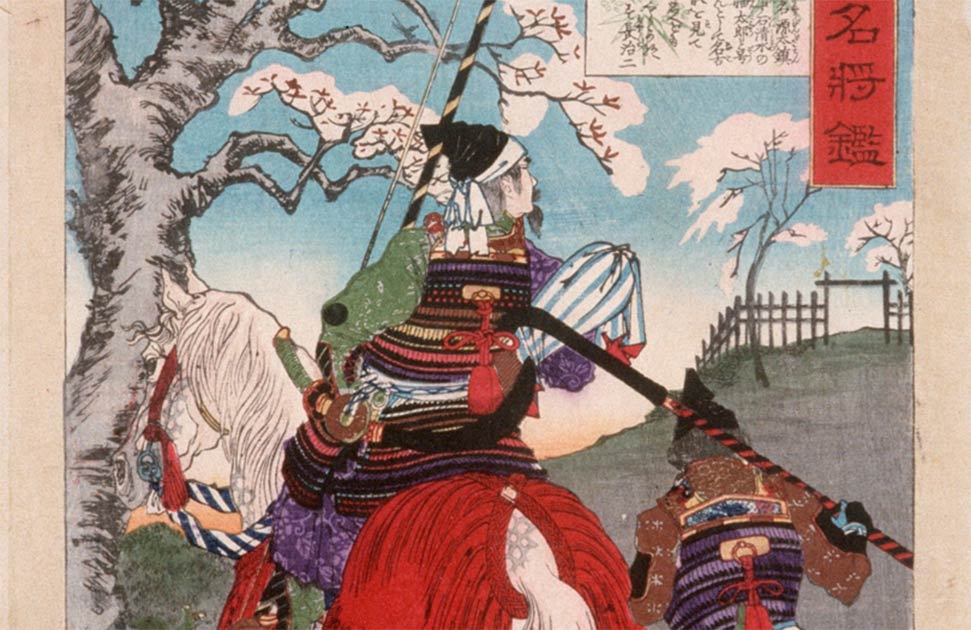Hachiman: Deified Emperor, War God, Protector Of The Japanese People
Hachiman is a Japanese Shinto deity who is often considered to be the god of war. Although he is worshipped as a Shinto god, Buddhist elements were incorporated into this deity, following the arrival of the latter religion in Japan in the middle of the 6th century AD. Moreover, Hachiman was included in the Buddhist pantheon, and worshipped by Buddhists.
Hachiman is commonly identified as the deified Emperor Ojin (201-310 AD) and is worshipped at Hachiman shrines throughout the country. In these shrines, Hachiman is normally venerated alongside his mother, who is also deified, as the goddess Hime Okami.
Hachiman is known also as Yahata no Kami, and his name literally translates to mean “The God of the Eight Banners.” This name connects the deity to Emperor Ojin, as eight heavenly banners are said to have appeared at the emperor’s birth. Ojin is a semi-legendary figure, who is believed to have been the 15 th emperor of Japan.
Moreover, numerous important political and cultural contributions to Japanese society are attributed to Ojin. For instance, the emperor is credited with the consolidation of imperial power, and the institution of land reforms. Moreover, he is believed to have been an active promoter of cultural exchange with Korea and China. Thanks to these foreign interactions, Korean weaving techniques, the Chinese writing system, and Confucianism were introduced in Japan.

The kofun burial mound, Japan's second largest, where Emperor Ojin, who was deified as Hachiman, is believed to be interred. (I, KENPEI / CC BY-SA 3.0)
The Legacy Of Emperor Ojin: Deified As Hachiman
Tradition has it that Ojin’s grave is in Habikino not far from Osaka. The emperor’s grave is of a type known in Japanese as a “kofun” meaning “old mound,” about 160000 of which have been identified around Japan. Ojin’s kofun is the second largest kofun in Japan, measuring 425 m (1394 ft) in length. The only other kofun larger than Ojin’s is the one belonging to Emperor Nintoku, his immediate successor, which is 486 m (1594 ft) in length, excluding the surrounding moat and ramparts.
It should be mentioned, however, that there is no solid evidence to prove that either kofun contains the tomb of an emperor. Still, the two ancient mounds are impressive, and, along with 47 others in the area, have been inscribed on UNESCO’s World Heritage List as the “Mozu-Furuichi Kofun Group: Mounded Tombs of Ancient Japan.”
Considering that Ojin made many significant contributions to Japanese society, it is not entirely surprising that he was deified after his death. This deification process, however, did not take place immediately after he died, but many centuries later. Although it is now commonly accepted that Hachiman and the deified Ojin are one and the same, it was not always so.
During the Nara period (710-794 AD), Hachiman was not yet identified with the deified Ojin, but had established himself as the protector of the Imperial Family. In 743 AD, Emperor Shomu issued an edict to build the Daibutsu (“Great Buddha”), which would be housed in Todai-ji, an important Buddhist temple in Nara. The story goes that Hachiman, through an oracle, promised the discovery of gold and copper for the casting of the Daibutsu. After the completion of the project, Hachiman was honored, and became the protector of the Japanese imperial family.

The genealogy of the Minamoto Clan in an intricate ukiyo-e woodblock print. (English: Utagawa Kuniyoshi 日本語: 歌川国芳 / Public domain)
It was only during the Heian period (794-1185 AD), which succeeded the Nara period, that Hachiman became identified with the deified Ojin. It was also during this time that the god was adopted by the powerful Minamoto samurai clan as their clan deity. One reason for this was that the Minamoto clan claimed descent from Ojin. Another reason is that since the Minamoto were a warrior clan, Hachiman, as a god of war, suited them perfectly.
There are plenty of examples demonstrating the close relationship between the Minamoto and this god of war. For instance, Minamoto Yoriyoshi dedicated a Hachiman shrine to thank the god for a military victory, whilst his son, Yoshiie, was nicknamed Hachiman Taro for his military prowess. Yoshiie was even believed to have been the reincarnation of Hachiman himself. In one story, whilst Yoshiie was campaigning against the Ainu in the far north of Japan, his troops ran out of water, and Yoshiie prayed to Hachiman for deliverance. The god told Yoshiie to shoot an arrow into a rock, which he did. Water gushed out from the rock, thus saving the army from dehydration.
Later, during the Genpei Wars, the Minamoto clan, led by Yoritomo, defeated their rivals, the Taira clan, and established the Kamakura shogunate. The Minamoto attribute their success in part to Hachiman’s divine protection. During the Kamakura shogunate, Hachiman was transformed into the protector of the Japanese nation.
In 1274 and 1281 AD, the Mongols, who ruled China as the Yuan dynasty attempted to invade Japan. On both occasions, however, the Mongol fleet was destroyed by powerful typhoons, referred to by the Japanese as “kamikaze” (literally “divine wind”). Consequently, Japan was saved from the Mongols. It is commonly believed that the typhoons were sent by Hachiman to save Japan from the invaders, and thus, the god became the protector of the Japanese nation.
- Yoshitsune: The Silk Clad Warrior With a Noble Quest for Revenge
- Purification as the Core of the Ancient Shinto Faith
- The Honorable Death: Samurai and Seppuku in Feudal Japan
The legend of the typhoons being sent by Hachiman shows that this deity is not only the patron of aggressive warfare, but also has a protective side to him. Hachiman is also worshipped as the protector of children, and the deity of general prosperity brought about by military strength. This is in line with the concept of “peace through strength.” Interestingly, Hachiman is also considered to be the patron god of spies. This is due to the belief that Ojin, whilst he was the emperor of Japan, would often disguise himself as a commoner, and roamed around the country, to learn about the actual living conditions of his subjects.

Traditional wooden prayer tablets (ema) at Shirakawa Hachiman shrine in Shirakawago, Gifu, Japan, a famous historic site. (beibaoke / Adobe Stock)
Hachiman Shrines Exist Throughout Japan
It is unsurprising that Hachiman is one of the most popular deities in Japan. According to various estimates, there are between 30000 and 44000 Shinto shrines (both registered and unregistered ones) in the country dedicated to this god. The only Shinto deity who has more shrines than Hachiman in Japan is Inari.
It may be mentioned that although Hachiman is a Shinto deity, he was also adopted by Buddhists in Japan. The story of the casting of the Daibutsu by Emperor Shomu, for example, demonstrates the connection between the god and Buddhism. In Buddhism, Hachiman is known as “Daibosatsu,” meaning “Great Buddha-to-be,” and is the first Japanese deity to be given this distinguished title. Additionally, in Buddhist art, such as statuary and paintings, Hachiman is depicted as a monk, another instance of how this foreign religion incorporated an indigenous deity into its pantheon.
As mentioned earlier, there are tens of thousands of Shinto shrines dedicated to Hachiman throughout Japan. The most important of these is Usa Jingu, known also as Usa Hachimangu, the “sohonsha,” or “head shrine” of the god. Usa Jingu is in the city of Usa in Oita, a prefecture on the southern Japanese island of Kyushu. Interestingly, although Usa Jingu was established as a Shinto shrine, it also gradually became a center for Buddhism, as Buddhist monks from China and Korea were invited to the temple.
It is quite rare for a Shinto shrine to also be a supporter of Buddhism, and hence, Usa Jingu is quite unique in this respect. Thanks to the shrine’s relations with China and Korea, and its fusion of Buddhism and Shintoism, Usa Jingu attained a high level of cultural influence and political power, so much so that it made a huge impact on the history and culture of Kyushu. It is estimated that at the height of its power, two-thirds of all the arable land on Kyushu was owned by the shrine. In terms of prestige, Usa Jingu is second only to Ise Grand Shrine, having received patronage from both the imperial family and the samurai warrior class over the centuries.
The main shrine hall of Usa Jingu, called Jogu, is designated as one of Japan’s National Treasures, and contains three altars. The altars, incidentally, are inaccessible to visitors. The three altars are dedicated to Hachiman, Empress Jingu, the deified mother of Ojin, and Hime Okami. The dedication of Jogu to this trio of deities is common in Hachiman shrines, as the god is seldom worshipped on his own.
According to legend, Empress Jingu launched an invasion of Korea after the death of her husband. At that time, she was pregnant with Ojin, but only gave birth to her son three years later, after the conclusion of the campaign. Hime Okami on the other hand is considered to be the wife of Hachiman. Incidentally, the name of this deity does not refer to a specific goddess, but the wife / daughter of the primary deity of a particular shrine. It is unclear as to which goddess the Hime Okami at Usa Jingu refers to, but one theory states that she is the deity of the original shrine on whose grounds the Hachiman shrine was built.

Tsurugaoka Hachiman Shrine in Kamakura, capital of the Minamoto Clan's Kamakura shogunate. (Fg2 / Public domain)
Another significant Hachiman shrine is Tsurugaoka Hachimangu, in Kamakura. Since the Minamoto clan chose Kamakura as their capital when they established their shogunate, it is only natural that an important shrine to the clan deity was built there. The original shrine was founded by Minamoto Yoriyoshi in 1063 AD. In 1180 AD, however, Minamoto enlarged the shrine, and moved it to its current location. Tsurugaoka Hachimangu is the most important shrine in Kamakura. One of more interesting features of Tsurugaoka Hachimangu is the nameboard on top of the foremost shrine building. The nameboard contains the characters “hachi,” “man,” and “gu,” the first of which means “eight” in Japanese and is represented by a pair of stylized doves. The dove is the symbolic animal and messenger of Hachiman. This association is interesting, considering that the same animal is regarded as a symbol of peace in Western culture.
Tsurugaoka Hachimangu is also known as the site where Minamoto Sanetomo, the third shogun of the Kamakura Shogunate, was assassinated. The incident occurred in 1219 AD, when Sanetomo was exiting the shrine after completing a ceremony that was performed there. As he was descending the great stairway of the shrine, the assassin, Minamoto Yoshinari, ambushed the shogun, and decapitated him. Yoshinari, who was Sanetomo’s nephew and adopted son, then penned a letter declaring himself the new shogun. The assassin, however, was hunted down, and executed several hours later.
According to tradition, Yoshinari hid behind a large gingko tree to the left of the stairway whilst he waited for Sanetomo to emerge from the shrine. Unfortunately, the tree did not survive the winter storm of March 2010 AD. It may be added that contemporary accounts of the assassination do not mention the gingko tree, and this element may have been included in the story later.

Iwashimizu Hachimangu Shrine in Kyoto, Japan. The shrine was founded in 859 AD and is a designated National Treasure of Japan. (beibaoke / Adobe Stock)
There are two other major Hachiman shrines in Japan – Hakozaki Shrine in Fukuoka, and Iwashimizu Hachimangu in Yawata. Hakozaki Shrine was established in 923 AD, when the spirit of Hachiman was transferred to the site from the Daibu Hachiman Shrine. This shrine was destroyed by the Mongols during their invasion in 1274 AD, but later rebuilt. Prior to that, the shrine served as a “korokan” (a guesthouse for diplomats), and then as a center of international trade.
Iwashimizu Hachimangu, on the other hand, was built in the 9 th century AD, during the reign of Emperor Seiwa. According to tradition, the emperor received an oracle who told him that Hachiman wanted a shrine near Kyoto so that he may protect the imperial capital and the imperial family. The emperor shared this piece of information with the monk Gyokyo, who so happened to have had a vision of his own, in which he was directed to build a shrine to the god on Otokoyama Mountain. As a result, Iwashimizu Hachimangu was built.
Hachiman: A Japanese God That Is Still Super Popular Today!
To conclude, it is clear that Hachiman was an important deity throughout Japanese history. As the imperial family and the ruling elite were patrons of major Hachiman shrines, these religious centers grew wealthy and powerful. Hachiman’s popularity, however, was not limited to the elite, as he was also immensely popular amongst the ordinary people, due to his role as a protective deity. Hachiman’s popularity amongst the Japanese people continues today, evident in the numerous shrines dedicated to him throughout the country.
Top image: Hachiman Tarō Yoshiie at Nakoso Barrier by Tsukioka Yoshitoshi (Japan, 1839-1892). Source: Los Angeles County Museum of Art / Public domain
By Wu Mingren
References
japan-guide.com, 2021. Tsurugaoka Hachimangu. [Online]
Available at: https://www.japan-guide.com/e/e3102.html
japan-guide.com, 2021. Usa Shrine. [Online]
Available at: https://www.japan-guide.com/e/e4722.html
JREF, 2013. Hachiman - the God of Archery and War. [Online]
Available at: https://jref.com/articles/hachiman.212/
Kato, 2017. Minamoto no Sanetomo, the 3rd Kamakura Shogun (September 17, 1192 – assassinated February 13, 1219). [Online]
Available at: https://samurai-world.com/minamoto-no-sanetomo/
MATCHA, Inc., 2021. Usa Jingu - The Highlights Of One Of Kyushu's Most Beautiful Shrines. [Online]
Available at: https://matcha-jp.com/en/6420
NIWAKA Corporation, 2021. Iwashimizu Hachimangū. [Online]
Available at: https://www.discoverkyoto.com/places-go/iwashimizu-hachimangu/
Schumacher, M., 2015. Hachiman & Hachimangū Shrines. [Online]
Available at: https://www.onmarkproductions.com/html/tsurugaoka-hachiman.shtml
Smith College Museum of Art, 2021. Historical Background of Hachiman Belief. [Online]
Available at: https://hachimanhandscrolls.com/background/historical-background-of-hach...
The Editors of Encyclopaedia Britannica, 2018. Ōjin. [Online]
Available at: https://www.britannica.com/biography/Ojin
The Editors of Encyclopaedia Britannica, 2019. Hachiman. [Online]
Available at: https://www.britannica.com/topic/Hachiman
The Sankei Shimbun, 2021. Emperors’ Burial Grounds: Mozu-Furuichi Tomb Clusters Now On World Heritage List. [Online]
Available at: https://japan-forward.com/emperors-burial-grounds-mozu-furuichi-tomb-clu...
UNESCO, 2021. Mozu-Furuichi Kofun Group: Mounded Tombs of Ancient Japan. [Online]
Available at: https://whc.unesco.org/en/list/1593/
Wozniak, E., 2012. Shinto Myths: Hachiman, the God of War. [Online]
Available at: https://glitternight.com/2012/11/13/shinto-myths-hachiman-the-god-of-war/
Yokanavi, 2021. Hakozaki Shrine. [Online]
Available at: https://yokanavi.com/en/spot/26931/
Yu, A. C., 2021. Hime no kami (比売神). [Online]
Available at: https://japanese-wiki-corpus.github.io/Shinto/Hime%20no%20kami.html




















Comments
Hi EL ROTTO,
Thank you so much.
It would be pronounced sort of like hah chee mahn. You can look up pronounciations online, as well. There are multiple sources with sound files for all sorts of foriegn words and names. Have a nice day!
Hi All,
This is certainly an exciting article to read about the Deified Emperor, god of war Hachiman. Question, I have is how does one say his name verbally and would anyone be kind to spell, it out for me so I can properly say Hachimans' name?
Thank you!
This is all I have to share until next time Everyone, Goodbye!